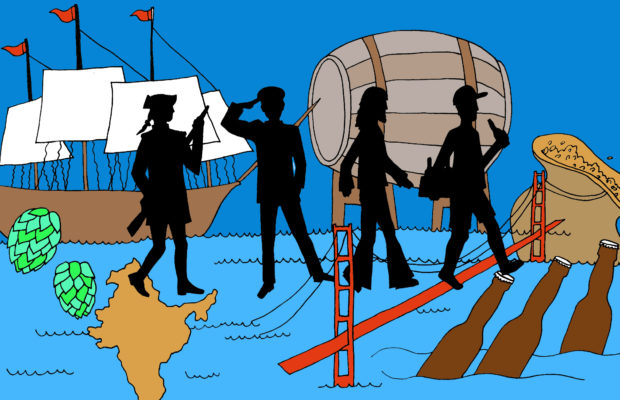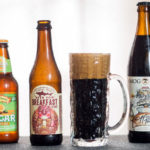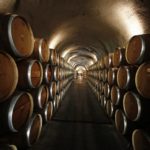A Brief History of IPA

Do you know the IPA origin story?
Over beers one recent evening at my apartment, my friend, David, was recounting a party conversation that turned to the question at hand. One guy swore he knew the story.
“It was invented in England to preserve beer on the journey to India during the 18th century,” he said.
David knew this was false. By the 1760s, British brewers fortified all beers bound for India and tropical climes with extra hops—the multipurpose flowers that bestow beer with flavor, aroma and bitterness.
“Did you tell him he was wrong?” I asked.
“It was a party,” he said. “I didn’t feel like arguing.”
While the IPA is the craft beer movement’s lifeblood, coursing through tap lines countrywide, the style’s origins and evolution remain largely misunderstood. Knowledge, it seems, has ridden a back seat to blind desire.
“The first question we’re asked is, ‘What IPAs do you have on tap?’” says Zack Kinney, who cofounded Brooklyn’s Kings County Brewers Collective. “Our best-selling beer is whatever IPA we have on tap. The second-best-selling beer is the session IPA—or the double IPA.”
The appeal of the IPA is its ability to pull every lever on the palate. These beers can be sweet and fruity, bitter and citrusy, funky and feral or as tropical as a Piña Colada. It’s a style, at least nowadays, ordained by a single directive: Add extra hops.
“What I tell brewers all around the world is that biggest differentiation of what we’re calling ‘craft beer’ and beer as we knew it before is the use of hops in a more aggressive manner,” says Firestone Walker brewmaster Matt Brynildson.
IPA THROUGH THE AGES
1760s — Breweries in England are advised to add extra hops to their beers to safeguard them from spoilage during long seafaring voyages to the Caribbean and, yes, India.
1835 — An edition of the Liverpool Mercury uses the phrase “India pale ale,” reportedly its first mention in print.
1878 — Ballantine IPA is first brewed in Newark, New Jersey. Aged in wood and lavishly hopped, it’s one of America’s earliest examples of the style.
1972 — The Cascade hop is released by Oregon State University’s USDA breeding program. Its floral, grapefruit-like profile will later lay the foundation for American IPA.
1975 — Anchor Brewing celebrates the bicentennial of Paul Revere’s ride by brewing Liberty Ale. Solely hopped with Cascade, Liberty is America’s first modern IPA.
1983 — Bert Grant’s Yakima Brewing and Malting Company releases the first beer to be labeled IPA in the modern era.
1989 — Denver’s Great American Beer Festival awards its first medals for IPAs. Gold? Rubicon India Pale Ale.
1994 — The Blind Pig brewer Vinnie Cilurzo unveils the Inaugural Ale, the first double IPA. Six years later, at Russian River, he releases the Pliny the Elder, igniting America’s double IPA boom.
2002 — Stone Brewing releases Ruination, the first West Coast double IPA to be bottled year-round. The bitterness arms race later reaches its peak with Mikkeller 1000 IBU.
2003 — Dogfish Head debuts 120 Minute IPA, a boozy bruiser that ups the ante for ABV, clocking in between 15 to 20 percent.
2009 — The Citra hop is officially released. Its profile of papaya, lychee, mango and citrus will help shift the IPA away from citric bitterness and toward tropical fruitiness.
2010 — Founders Brewing distributes the low-alcohol All Day IPA, which later becomes the first widely distributed session IPA.
2011 — Vermont’s The Alchemist cans Heady Topper, its aromatic, hardly bitter double IPA. It’s the beer that ignites the IPA canning craze.
2012 — Floral, peachy and unabashedly tropical, Mosaic hops become America’s next hot IPA hop.
2015 — Ballast Point releases Grapefruit Sculpin, the citrus-infused variant of its flagship IPA, igniting the widespread craze for fruited IPAs.
2016 — Both sour and milkshake IPAs arrive, further expanding the style’s definition.
In certain respects, this practice harks back to the style’s start. During the 18th century, hops were used to balance malt sweetness, with the added bonus of their preservative properties warding off spoilage in beer—essential during the long sail from Britain to India, then under the the control of the British Empire. As shipments to India gradually increased, so did hopping levels, leading to “pale ale prepared for the East and West India climate,” as Britain’s W.A. Brown Imperial Brewery advertised in 1817. (Domestically sold British pale ales used fewer hops.)
While British brewers regularly made the style that would become the IPA by the early 1800s, the first printed codification (in the Liverpool Mercury) as “India pale ale” didn’t come until 1835. By this time, the prevailing style of “India pale ale” was an evolution of the strong and somewhat sweet Burton Pale Ale, singular thanks to the local gypsum-spiked water (which, thanks to elevated levels of calcium sulfate, gave the beer a drier, more bitter flavor). When Russian tariffs banned British imports to the Baltic, then a major Burton Pale Ale market, the East India Company tapped Burton brewers to replace London-based Bow Brewery, whose greediness led the importers to end the arrangement.
The style persisted, but by the early 20th century, the crisp Czech pilsner had superseded IPA on its path to world domination. It did, however, hop the pond prior to its UK decline—hastened by taxes and the temperance crusade—most notably to Newark, New Jersey’s Ballantine, which aged its generously bittered IPA in oak casks. The beer endured for nearly 120 years until its 1996 discontinuation. By that time, the rebirth of the IPA was already in full swing.
The modern American boom of the style can really be traced back to two beers, beginning, in 1975, with San Francisco’s Anchor Brewing Liberty Ale, which was brewed with a new hop called Cascade. Floral and full of grapefruit bitterness, Liberty was freedom from light lager tyranny—an early IPA even if it lacked the descriptor. Eight years later, Bert Grant’s Yakima Brewing and Malting Co. was the first beer to pair the style with its proper moniker.
“[Anchor] Liberty and Grant’s were the basis of the American style of intensely hoppy, aromatic IPA,” wrote the beer expert Michael Jackson back in 2001. “[But] Grant’s brought back the historic name and made it part of our beer vocabulary again.”
The IPA gradually became a weapon in craft brewers’ battle against conglomerates. The mid-1990s welcomed Lagunitas IPA and Stone IPA, symphonies of citrus and pine that solidified the West Coast as a stylistic trailblazer. Sierra Nevada first underscored IPA’s seasonality with Harvest Ale (1996), using freshly picked hops—greener and more delicate than standard dried hops—to create a new fall category. But the IPA wasn’t solely a West Coast delicacy. Harpoon IPA (1993) and Brooklyn East IPA (1995) were early reps for the East Coast, while Bell’s Two Hearted Ale (1993) and Goose IPA (1997) held it down for the Midwest.
Looking back, these early examples seem quaintly restrained. By the mid-aughts, the IPA began to push international bitterness units (IBUs, a measure of a beer’s perceived bitterness) and alcohol ever higher. Russian River’s Pliny the Elder (2000), as resinous as a pine tree and clocking in at eight percent ABV, became the archetypal double IPA. Then came the stronger triple (ten to 12 percent) and quadruple (12 percent and up)—expressions that pushed the very upper limits of flavor and drinkability. Consuming beers like Stone Ruination, Green Flash Palate Wrecker, Dogfish Head 120 Minute IPA or Mikkeller 1000 IBU was equivalent to eating an incendiary Carolina Reaper—it was drinking as double dare. (Today, “I don’t like IPAs,” remains a common refrain, largely a hangover from the IPA arms race era.)
In reaction to this movement toward the edge of drinkability, the IPA has, over the last half-decade, undergone yet another evolution. Founders’ All Day IPA (first released seasonally in 2010, and year-round in 2012) ignited the full-flavored, low-alcohol session IPA craze. Simultaneously, Northeast brewers like Hill Farmstead, the Alchemist and Maine Beer Company began creating hazier, juicier IPAs with gale-force fragrances—their jagged bitterness sanded smooth. Brewers turned this trick with freshly developed, fruit-forward hops such as Citra, Mosaic and Galaxy, grains including wheat and oats, and the addition of hops at brewing’s end, heightening aroma and flavor without the bitter bite.
“There’s no reason a double IPA can’t drink like a pale ale,” says Alex Tweet, head brewer at Berkeley’s Fieldwork Brewing. The brewery, which creates a range of softer, fruitier IPAs, makes pale ales as flavorful as stronger beers, while their aromatic double IPAs drink lighter and drier. “It doesn’t always have to be this big, arduous, heavy resin bomb,” he says.
So here we are in 2016, the IPA arguably more popular than ever. Aficionados queue for hours at L.A.’s Monkish, Brooklyn’s Other Half and Richmond’s The Veil to buy freshly canned IPAs—fetish objects rabidly traded online. The flamboyant, Americanized IPA has spread to Stockholm, Tokyo and Berlin, where Stone just opened a European outpost.
The style has also become a diving board from which brewers have leapt into uncharted waters, using hops, grains and yeast strains to set offerings apart. IPAs are now black and white, squeezed with grapefruit, fermented with lager yeast and laced with lactose to emulate milkshakes.
“Session, Brett, Double, Red, White, Green, Triple, what flavor of IPA do you want, sir?” wrote beer expert Lew Bryson in the September 2016 issue of All About Beer. “We have everything.”
More than two centuries after its invention, the IPA’s only true definition, it seems, is that it should forever be changing.



![The Survival Code [EP] – Broken Strings](https://www.crushbrew.com/wp-content/uploads/2017/02/GGuitar2-150x150.jpg)













